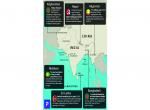In all ages, major geopolitical events, wars and warfare has been an important topic of analysis, mostly by historians, as post-script. Can these be predicted, in their likelihood, broad timeframe, typology and the likely political and military end-states? Have eminent strategicians and thinkers been able to forecast strategic future to accuracy? The assassination of the Archduke Franz Ferdinand was unanticipated, as was the subsequent crisis that triggered the First World War. Historians later showed evidence of rampant arms build up, vociferous imperialism and excessively complicated complex alliance system among the world’s ‘great powers’ that had led the Great War. It was but conflagrated by a single unpredicted spark.
The self-immolation of a street vendor Mohamed Bouazizi in protest of police corruption and ill treatment on 17 Dec 2010 sparked the first protests in Sidi Bouzid, Tunisia. From Tunisia, the protests spread to five other countries: Libya, Egypt, Yemen, Syria, and Bahrain, deposing off the rulers (Zine El Abidine Ben Ali, Muammar Gaddafi, Hosni Mubarak, and Ali Abdullah Saleh) or led to major uprisings and social violence. There were unrelenting street demonstrations in Morocco, Iraq, Algeria, Lebanon, Jordan, Kuwait, Oman and Sudan. There were minor protests in Djibouti, Mauritania, Palestine and Saudi Arabia. Protracted, major conflicts resulted in the Syrian, Libyan and Yemini Civil Wars, Crisis in Egypt, insurgency in Iraq and the rise of (Islamic State of Iraq & the Levant (ISIL). There was also the massive geopolitical event in late 1980s – the breakup of the super power, USSR! Similarly, the US involvement in Afghanistan for two decades – the longest war, was never analysed in this form by any of the erudite think tanks globally. Millions, in many such events, paid with their lives, with no mythical Cassandra, soothsayer, analyst or strategician forecasting the likely turn of events!
Closer home, the times of Lahore bus Yatra in Feb 1999, one could never have foretold the ongoing preparations by Pakistan Army that led to Kargil War in May the same year. Neither did President Xi Jinping’s visit to India in Oct 2019 indicate any likelihood of Chinese aggression in Eastern Ladakh in 2020 that led to the casualties in Galwan and continued stand-off! In fact on the contrary, series of Agreements and Protocols signed from 1993 to 2013, and the continuous meetings between India and China over three decades, had been seen as signs of rapprochement.
Predicting future scenarios is, hence, a majorly onerous task. Hans Morgenthau had stated that “...complexities of international affairs make simple solutions and trustworthy prophecies impossible.” To analyse and project likely strategic scenarios is an imperative for any nation. Enunciation of short and long term security strategy is inevitably based on the appraisal of the prevailing, and the perspective geo-strategic environment. In addition to domestic politics, organizational inertia, psychological barriers and learning the wrong lessons from history, failure of security strategies is also due to inappropriate assessment of the environment. Historically, armed conflicts are too complex to allow prediction. Also what caused the conflicts of yesterday is unlikely to be useful to anticipate those of tomorrow. The greatest challenge of our times is to be able to make correct and timely assessments of the changes taking place and the nature and extent of challenges and opportunities they present.
To consider the futuristic environment on which long-term policy decisions have invariably to be based, a distinct rationality is necessary. The most prevalent method to rationalise is scenario building. Scenarios are consistent hypotheses of how future will unfold, with a chain of logic that connects the trends and drivers to likely outcomes. Government long-term planning typically focuses on the scenario-building approach, as it provides clear cut alternatives. This methodology, however, suffers from the weakness of postulating future on current trends, though there are always pockets of the future in the present. Scenario building should be separated from ongoing operative doctrine, strategy and planning activities. This is essential for exchange of ideas and visions that are disengaged for the daily political and strategic agenda. Scenario building must also be pragmatic to avoid the trap of looking excessively in the "rear-view mirror". Having a baseline or a basic long-term trends or drivers will be advantageous.
As an example, five significant baselines are briefly examined. First, China is determinedly moving towards the Great Rejuvenation and Global ambitions, by buying global influence steadily, and attempting to create Pax-Sinica. To achieve a super power status, China will not to allow its global ambitions to be trapped in regional peripheral problems, like those with India, Taiwan, Japan or in South China Sea. Eventually, China will attempt to resolve the peripheral issues in all manners suitable to it, even by force if necessary. The end-state of Chinese endeavours may not, however, be assured, with pressures that China will get from its periphery. The geopolitical relationship of China with the US in the future, will also affect the region as well, including Chinese attempts to continue expansionism along its territorial borders and maritime arena.
Second, China has tried to fix the LAC, by expanding settlements all along its disputed boundaries with India with Xiokang villages, using ‘civilians’ to protect ‘sovereignty’. China may also oppose construction of border infrastructure by India, citing its new land law aimed at “protection and exploitation of the country’s land border areas” which will come into effect from 01 January 2022. This new Law prohibits building permanent structures in the border areas without permission of Beijing. The Law stating that “the sovereignty and territorial integrity of…China are sacred and inviolable”, has ominous portends. China may also in future cite its border villages and infrastructures to counter boundary claims of India. The situation that has emanated in Eastern Ladakh also exhibits that Aksai Chin is becoming a belt of actual control as against a Line of Actual Control. This suits China the best. It is opined that all access towards Aksai Chin, will stand largely denied by this new Belt of Actual Control. The last WMCC statement by the Chinese reads that to “further ease the situation in the border area and strive to switch from emergency response to normalized management and control”. Simply stating, the Chinese have intimated that the status achieved along Eastern Ladakh should lead to normal management, hereinafter, thereby fixing this LAC in permanence! The pressure in other areas, as in North East will continue, as is evident by the recent ‘renaming’ of Arunachal Pradesh areas with Chinese names! It is likely that Chinese have announced that the resolution of the boundary question through negotiations is past and that sovereignty will be assured through other means that is use of force. Terrestrial tensions, hence, are bound to last for much longer time.
Third, Pakistan, a nation with an important geostrategic location, had taken birth without a clear identity. It has also been unable to create and nurture one subsequently, and maintaining integrity itself is an onerous task. Its current very poor economic state and conditions attached to soft loans from IMF are adding fuel to fire, within the country. Pakistan, hence, needs an adversary in permanence to retain itself as a nation-state. India as a perpetual adversary is necessary, to therefore continue to lend credence of its identity. Scenarios anticipating great socio-political change and move to betterment of relations with India in future that may lead to attitudinal change, may be far-fetched. Such major transformation in Pakistan cannot happen without attendant internal upheaval and instability.
Fourth, with China spreading wings, Indian Ocean is becoming an arena for great power competition. For India, it brings immense opportunities to leverage partnerships and create collaborations with Australia, France, Japan, the United States and other peripheral nations. There are also new geopolitical challenges and strategic dilemmas and threats. There are increasing collaborations between China and Indian Ocean peripheral nations. Despite increasing ambitions of PLA Navy, it will not be easy for it to attempt contestation in the Indian Ocean and the global commons, as it is stuck, in dire maritime strategic geography.
Fifth, warfare has transcended beyond the three Services – Army, Navy and Air Force. New and modern domains of warfare like cyber, space, electro-magnetic spectrum, informational have emerged, most of which are in the Governmental realm. More fundamentally, the notion of warfare conducted in newer operational domains, may simply not require kinetic warfare to achieve political ends! The lines between peace and war already stand subsumed or blurred. Since the domains of warfare have proliferated, multiple agencies will be equally involved in combat like Central Armed Police Forces (CAPF), National Security Council Secretariat (NSCS), National Technical Research Organisation (NTRO), National Cyber Security Coordinator, DRDO, ISRO and Atomic Energy Commission.
India maybe spending say up to 1 Trillion USD on Defence Budget alone in the next decade, of which nearly one third should be on Capital Procurement necessary for capability building. It is always possible likely that any future projections or strategy based upon any type of modelling, may prove incorrect or remain short. However, projections are mandatory to ensure that such large outlay on capital acquisitions is not dissipated on inessentials, and that dynamism is built-in to cater for constant appreciations.
India has to develop a well conceptualized strategic VISION, distilled from a basket of disparate ideas and imagination, scenarios and net-assessments. These have to be articulated with a large-picture orientation of an immediate, mid-term and distant future. This vision must be in sufficient detail to summarize the strategic objectives and intentions and be conceptual in accepting the complexity of the future. It must also encompass the thrust of technology and the structures imperative to implement it. The enunciated vision should be potent enough to stir imagination to build political consensus internally and create imperatives to shape the political environment by effective communication. Creating the VISION itself will be an intensive process that would require a broad based intellectual debate. Points of view must be impressed upon, substantiated, reasoned and accepted or negated.
The current strategies may have outlived their utility, in an era where nuclear weapons are spoken off as weapons of conventional warfare by the Western adversary. Definition of war itself has become contentious, with non-contact, non-kinetic, proxy, informational, undeclared and hybrid are all typologies of war. Understandably, strategists had in the past forecast and laid down strategies that did not succeed during implementation. As the strategy is built on the assumptions of the future, it can go wrong. That must not deter visualisations of the future that we want and may get it, or a future that we do not want, but yet may still get it! This security visualization and technological environment is challenging us in crafting visions and devising optimal strategies, necessary to assist in translating own ‘audacious dreams and ideas’ into reality.
Strategy is about winning, where defining victory itself is contentious! Sir John Chipman heading the IISS had once famously stated that “…the world in the 20th Century lived tactically but in the 21st Century the world will have to live strategically”.
(The paper is the author’s individual scholastic articulation. The author certifies that the article/paper is original in content, unpublished and it has not been submitted for publication/web upload elsewhere, and that the facts and figures quoted are duly referenced, as needed, and are believed to be correct). (The paper does not necessarily represent the organisational stance... More >>
Image Source: https://images.livemint.com/rf/Image-621x414/LiveMint/Period1/2014/05/28/Photos/narendra%20Modi-1--621x414.jpg











A thought provoking article that should ignite minds to look ahead and focus on the future instead of solely relying on history and the past to predict the shape of things to come.
Post new comment